arts organizations
Archived Posts from this Category
Archived Posts from this Category
Posted by ben on 13 Jun 2010 | Tagged as: announcements, arts organizations
Linda Pace Foundation announced that it has named Steven Evans, who currently serves as Dia:Beacon’s managing director, as its new executive director and curator. The foundation primarily manages the collection of Linda Pace, the late founder of Artpace San Antonio. It has been planning to build a David Adjaye-designed museum to house the collection, and also runs CHRISpark, commissions new works, and supports Artpace. Evans’ management could have a major impact on the San Antonio art community, especially if he is able to bring the museum project to completion.
Although Linda Pace Foundation and Artpace are separate entities, they are politically and financially intertwined, so the naming of a new director at Linda Pace Foundation could impact Artpace in a number of ways, although I wouldn’t expect the relationship between the two organizations to change in any fundamental way.
For those who aren’t familiar with it, Dia:Beacon is considered to be among the best collections of contemporary art in the world. It focusses on displaying large installations of major works by a relatively small number of artists, prioritizing depth over breadth.
4 Comments »
Posted by ben on 22 Oct 2009 | Tagged as: art + bikes, arts organizations, celebrations, conceptual art, free food, graffiti, public art
This is a little reminder of some of the art events on this busy weekend.
Don’t miss any of this stuff! Seriously!
Posted by ben on 21 Sep 2009 | Tagged as: adventure day, arts organizations, photography, responses/reviews
I just posted my take on the Ansen Seale installation mounted by the Land Heritage Institute over at Glasstire. LHI is positioning itself at the intersection of a number of different issues and movements, potentially functioning simultaneously as a park, an educational resource, an equestrian center, an advocacy group, a think tank and an art center. It should be interesting to watch how the whole thing plays out — the series of events that led it to where it is today has not exactly been predictable, and I doubt its future development will be either. In any case, I’m looking forward to LHI’s “art-sci symposium” The Nature of Place next month. With participants like Sandy Stone, Lucy Lippard, Erik Knutzen from the Center for Land Use Interpretation, and Anjali Gupta from Art Lies, it should be interesting to say the least. We’ll keep you posted.
Posted by ben on 18 Aug 2009 | Tagged as: adventure day, art + bikes, arts organizations, performance art, public art, renegade performances

A Los Angeles Urban Ranger explaining something
The LA Times has a story up about the Los Angeles Urban Rangers, a group of “geographers, environmental and art historians, artists, curators, architects, and others” who dress up like park rangers and teach people how to enjoy public urban space responsibly. They lead urban safaris, such as a “guided hike of Hollywood Boulevard that deconstructed the famous street as if it were a natural park.” They teach people how to (legally) enjoy Malibu beach fronts where the homeowners have often (illegally) posted “Private Beach” signs.
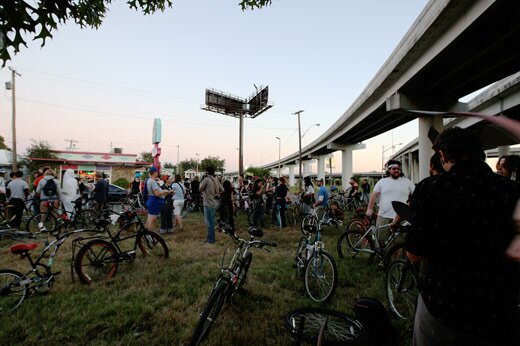
San Antonio's Bike Gang Summit, 2008 (photo: Justin Parr)
This is what performance art should be: seductively entertaining while challenging implicit assumptions about what constitutes public space and how it should be used. In their own way, the Final Friday bike rides (and Bike Gang Summits) in San Antonio encourage this kind of urban exploration, albeit with less explicitly pedagogical goals. Mark Jones and the rides’ other organizers lead bikers through obscure urban environments on the edges of downtown, descending on unlikely VFW halls and pocket parks. It’s a social sculpture if there ever was one.
Posted by ben on 24 Jun 2009 | Tagged as: arts organizations, books, conceptual art, coverage, design, photography, responses/reviews
Dan Goddard, the Express-News’ long-time art critic who was recently canned in a round of layoffs, has just published two good articles dealing with Linda Pace properties. In the San Antonio Current, he discusses the fate of Pace’s storied art collection, and it’s forthcoming permanent home. Designed by British architect David Adjaye specifically for the Pace collection, the project is on hold due to the economic downturn. Apart from that news, which I’ve been hearing unofficially for a while, Goddard reveals many interesting tidbits about the collection, Linda’s personal relationships with various artists, and the ongoing activities of the foundation. I was excited to learn that the Linda Pace Foundation is funding a public work by Jesse Amado to be installed at the downtown library (it will surely be a welcome contrast to their Chihuly).
On Glasstire, Goddard reviews Jonathan Monk’s “Rew-Shay Hood Project Part II” at Artpace. There’s some good context here for understanding the subtleties of the show, from Monk’s history with appropriation to Rucsha’s Catholic background, right down to curator Matthew Drutt’s obsession with vehicle-related art. That Goddard brings up Dave Hickey’s discussion of Ruscha is interesting, given Hickey’s interest in custom cars as an artistic medium. Some people I’ve talked to about the show come away with the impression that Monk is having the Ruscha photos painted on car hoods from the same period; Goddard points out this isn’t the case, the hoods come from one or two decades later than the photos. Perhaps what’s going on here is a contrast between the beginning of the idea of an “artist’s book” (the move away from the artist creating singular, unique objects) and the end of the era of the custom muscle car. As Goddard points out, the push for more efficient, less polluting cars using computer technologies pushed out custom car hobbyist culture to a large extent. But the rise of these computer technologies also empowered artists to move into their own mass production, at the same time allowing the kind of appropriation that Monk himself uses. Although Ruscha wasn’t using computers to produce Twentysix Gas Stations (and I don’t know if Monk used them in his reproductions), they are the descendents of the mass-production technologies that printed Twentysix Gas Stations, and Monk’s relevance certainly has a lot to do with them. Thus in the show we have the suggestion of a kind of ebb and flow, technology and the markets at certain points inspiring very personal expression, at other points depersonalizing art even to the point that it becomes design. And isn’t Monk here acting more like a designer than an artist, if by design we mean depersonalized visual communication?
Posted by ben on 11 Jun 2009 | Tagged as: arts organizations, celebrations, rumors, sneak peeks
I’ve been digging around a bit for details about tommorrow’s Artist Foundation fundraiser, the ArtBall (aka aLadaDadaGala). I managed to get ahold of a list of artists in the auction, although I don’t know how complete it is:
Anne Wallace, Ansen Seale, Ben Mata, Bettie Ward, Charlie Morris, Chris Sauter, Cruz Ortiz, Diana Kersey, Ed Saavedra, Enrique Martinez, Franco Mondini-Ruiz, Gary Sweeney, Hills Snyder, Jeremiah Teutsch, Jerry Cabrera, Jessica Halonen, Jim Keller, Joey Fauerso, John Mata, Kelly O’Connor, Ken Little, Kristy Perez, Leigh Anne Lester, Loretta Rey, Louis Vega Trevino, Mark Hogensen, Marlys Dietrick, McKay Otto, Michele Monseau, Peter Zubiate, Richie Budd, Susan Budge, Susan Strauss, Thomas Cummins, Trish Simonite, Dan Borris, Scott Lifshutz
I’ve also heard that there will be a reading from a Dada play (Pere Ubu Ubu Roi??), and a performance by the Saint Lorraine Dance Company.
Two artists in the auction have posted images of their ArtBall pieces on Facebook: Michele Monseau and our own Justin Parr. I also hear that a bicycle custom-painted by Alex Rubio, and a library of signed books by San Antonio authors will be auctioned. I’ll update this post as I hear more…
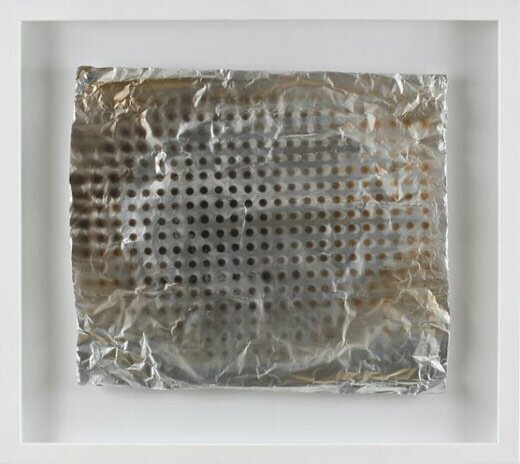
Justin Parr

Michele Monseau
UPDATE: Here’s Hills Snyder’s contribution to the auction:

Hills Snyder
Posted by ben on 10 Jun 2009 | Tagged as: announcements, arts organizations
Contemporary Art Month just posted their calendar on the website. Lots to sift through.
Posted by ben on 09 Jun 2009 | Tagged as: arts organizations
Uh oh. San Antonio’s newest museum’s website has been hacked, , and with only days to go before the acclaimed Phantom Sightings show closes:
Of the 7 pages we tested on the site over the past 90 days, 7 page(s) resulted in malicious software being downloaded and installed without user consent. The last time Google visited this site was on 2009-06-09, and the last time suspicious content was found on this site was on 2009-06-09.
We see website security breaches all the time, so this doesn’t necessarily reflect poorly on the Alameda’s web team, but I hope they’re working overtime to get it fixed.
UPDATE: As long as we’re on the topic of museum websites, I just went to the McNay’s site and found:

UPDATE II: It’s June 11th, and it looks like our museum websites are safe & accessible. Alameda purged their malware and McNay fixed their scripting bugs. Whew.
Posted by jason + leslie on 13 May 2009 | Tagged as: arts organizations, interviews
Potter-Belmar Labs interviews Matthew Drutt
April 21, 2009, San Antonio TX
Matthew Drutt rides through cycles of change. That’s really what he does. He served at the Guggenheim during that institution’s unprecedented decade of expansion, branding, and acquisition, including the new locations in Bilbao, Berlin and Las Vegas. (He was also one of the main people responsible for the controversial and wildly popular Art of the Motorcycle exhibition, there.) He then became curator at the Menil Collection in Houston during the difficult years that followed the death of legendary founder, Dominique de Ménil. In 2006, he came to San Antonio as the Executive Director of ArtPace, and a year later, founder, Linda Pace, passed away. Matthew has been leading ArtPace ever since, through unprecedented times, with deftness, and a sense of purpose both cool and passionate.
We began by talking about those Guggenheim boom years.
Matthew Drutt: I was part of a very small crew at the Guggenheim that planned these sort of satellite museums. I was brought in almost immediately to work on Bilbao, which was just beginning to evolve from a drawing on a napkin to a set of plans for a real building. The way [then-Director of the Guggenheim] Tom Krens worked tended to be in a very mentoring capacity, but with a very small group of people. There was this crew of five to eight people at the beginning, that of course grew as the project started to come on line, but the cast of characters who worked on proposals to build Guggenheims around the world was quite small.
That was a very exciting time to be there, especially in the beginning when we hadn’t built anything yet, and it seemed like anything was possible. At a certain point there were proposals coming in from all over the planet from people who wanted a Guggenheim Museum, especially after October of ‘97 when Bilbao opened. In the months that ensued, it was like we had invented the paper clip, and everybody wanted one. And so, I was literally churning out proposals to build Guggenheim in Lima, Guggenheim in Seoul. It was just amazing.
Emvergeoning: And there were moments when such a vast empire seemed possible?
All of those moments seemed possible because Tom– he kept a lot of balls in the air, and he’d get these people to the table. You had meetings with the head of Sony and the head of Samsung, the CEO of Deutsche Bank. Some of them happened. Deutsche Bank happened, there’s the Deutsche Guggenheim in Berlin. Bilbao opened and became this huge success that was kind of our calling card. We had a lot of leverage at that time because we had done it, and everybody, as we were going towards the opening, was doubting it, poo-pooing it, calling Krens a megalomaniac.
There was a lot of nastiness in the way that the Guggenheim was perceived as a wanna-be, and then we did it. We opened Berlin. And then we had plans for a Gehry building in New York, and we had heads of state coming to open our exhibitions, and partnerships with the Hermitage and the Kunsthistorisches Museum in Vienna, and the Louvre. Suddenly people started to… not be silenced by this, but the wind went out of the sails in terms of what a dumb idea all this was because it was working, and the money was flowing.
But what can I say? It was the ‘Ninties. So it was kind of like the mortgage business. It was booming. And it really didn’t blow up until Las Vegas opened on the heels of 9-11. And that’s what really undermined the whole thing because the Las Vegas project was based on a very sound business model regarding tourism in Las Vegas, and what people were looking for. 9-11 killed Las Vegas tourism, and casinos closed. So if casinos are closing, a museum doesn’t have a whole lot of… juice.
But those were the days when I would get a call at 4 o’clock in the afternoon telling me I had to take a trip to Germany, and I’d say “That’s cool, when?” “Tonight.”
(laughter)
“Go home, grab some things, and be at the airport by 7 o’clock. You’re going to Karlsruhe to do a presentation, and you’re coming home tomorrow night.” I would keep a bag packed for little overnight trips. So that was a very exciting time to be there.
Emvergeoning: Has it ever helped an artist to be from Texas?
Posted by ben on 02 May 2009 | Tagged as: arts organizations, photography, possibilities, responses/reviews
Just back from New York, and I must say I agree with Holland Cotter that it’s enlightening to see the Met’s “The Pictures Generation” show alongside the New Museum’s “The Generational: Younger than Jesus.” I also agree with him that the former is a much stronger and more carefully curated group of work than the latter. But at the same time, I don’t think it’s quite right to say that the “generational parallels are so many as to be worrisome. Has new art come no further than this? Is it still tilling fields all but farmed out in the past?”
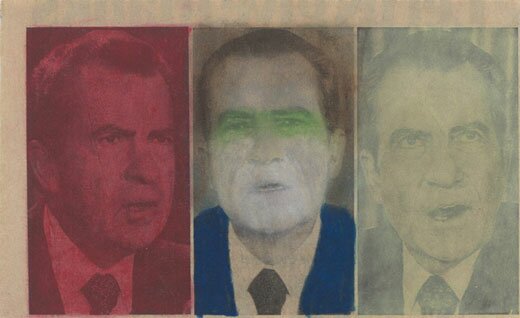
One reason to question this reductive view of current appropriation-driven art is articulated well in an article by Jan Verwoert published a couple of years ago in Art & Research. In it, Verwoert makes a distinction between the appropriation art that was produced in the 1970s and ’80s (see “Untitled (Nixon)” by Paul McMahon above), and another kind of work that emerged in the 1990s. The younger group of artists employ similar strategies as their predecessors, but with different implications. The basic premise is that during the Cold War history had frozen due to a superpower stalemate, and artists such as Robert Longo and Cindy Sherman analyzed culture through the lense of a detachment from history. In the ’90s the movement of history sprang to life again, and the act of appropriation became something more like the act of invocation: “To utter words for the sake of analysis already means to put these words to work. You cannot test a spell. To utter it is to put it into effect.” Artists had to wrestle with the ghosts of the past (a “multiplicity of histories”) as well as the life of the moment, as they dealt with a quickly evolving relationship to history and its connections to the present.
It seems to me that since 2001, this sense of living in a web of histories has only accelerated: from September 11 to Obama, China’s waxing cultural influence to the perpetually imminent collapse of Pakistan, commentators are stumbling over themselves to declare the dawn of new era after new era. It has the urgency of the 1960s, even if the cultural shifts are of a different nature. The ’60s produced a large body of art — both Pop and Conceptual — which resisted metaphor and was later synthesized by the ’70s “pictures generation” artists. But at the same time that this work resisted metaphor, it simultaneously helped open up space for a reinvigoration of metaphor and symbolism, a space that was filled by artists from Kenneth Anger to Martin Luther King (see “” and “I’ve Been to the Mountaintop“). Our moment now is different from the ’60s in many ways, but I think we are seeing a similar opening for a resurgence of the poetic, largely lacking from the artwork of “the pictures generation.”

So while I found the pieces at the New Museum generally stale and incoherent (see “Deep Breathing” by Cao Fei above), it’s not because the artists are simply rehashing Barbara Kruger or Jack Goldstein. It’s because the artists in the show generally don’t meet the poetic demands of the moment. They’re caught, unable to take the extra-historical viewpoint of their ’70s counterparts, but unwilling to make the poetic commitments of earlier artists. That’s not to say that other young artists aren’t invoking the past with an incantatory symbolization: it’s just not apparent in the vast majority of the pieces in “Younger than Jesus.”

Aaron Curry’s sculptures and prints (see “Cosmic Knot #2″ above) at Michael Werner wove found material and invocation of modernist artworks together in a way that revealed, in the words of Bruce Hainley, “an artist who wishes to make thrilling rather than pernicious the attempt to wrest from the global barrage something inappropriable, irreducible, and questioning, which acknowledges what comes before it, culturally, and from where it arrives without merely desecrating it.” I sense in Hainley’s words (which come from the catalog for the show) a suggestion of the kind of invocation Verwoert proposes. Curry’s show is a thriller, raising the spectre of modernism dwelling somewhere in the water of our reservoirs — not as a chilling memory, but as a living ghost prepared to inhabit our fields, our livestock, our bodies.
UPDATE: This interview with Bruce High Quality Foundation in Art in America seems too pertinent not to add here. From the discussion of Sept 11 as their “creation myth” to the invocation of multiple histories, there are a lot of parallels between this post and the interview. Although I visited the Bruce High Quality studio during my trip, their recent show had just come down, so I missed their new work both in the gallery and in the studio — otherwise they may have made it into the original post.
Posted by ben on 20 Apr 2009 | Tagged as: architecture, arts organizations, celebrations, performance art, public art, r.i.p., video/film
When I was working on my first art review back in 2006, I saw a version of Edgar Arceneaux’s video “Old Man Hill” at the Artpace potluck that launched his residency there. The residency project (which later wound up in the Whitney Biennial) wasn’t as impressive as this simple homage to a man he never met: his father’s father. Arceneaux spelled out the only thing he ever knew about this man — that he was called “Old Man Hill” — in silver balloons, which hovered over the war-torn hills of Sarajevo. One by one the balloons released and twisted toward the sky. The cameras followed the balloons wistfully, clinging to these insubstantial forms seeking oblivion. Occasionally the cameras cut to people going about their lives in the city below, people looking away from these hills with their burned out buildings and piles of rubble.
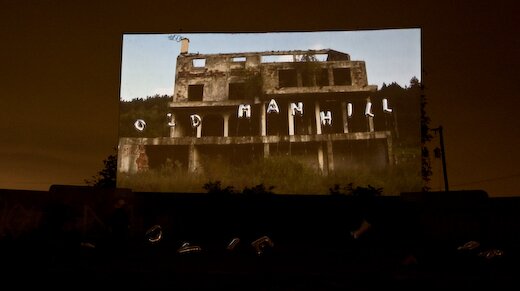
Linda Pace, who had not yet embarked on her battle with cancer, purchased this piece for her collection. Other than that potluck, the video had never been shown publicly; but before she died, Linda asked that it be screened at a special time, with the artist present. The Linda Pace Foundation arranged to screen the final version of this video for Linda’s birthday, last Thursday. Arceneaux was flown in to stage a performance along with the screening. The site selected for the project was the Mission Drive-In, a once-popular drive-in theater now dilapidated, graffiti-strewn, and slated for destruction. (It will be replaced with a new public library).
The evening of the event was overcast, windy, threatening rain. We got there early, and wandered around the old drive-in, its pavement giving way to grass, but its screens still fully intact. One by one, silver balloons were filled up and placed in front of the main screen, spelling out words that were unfamiliar to us, apparently a translation of “Old Man Hill” into Serbian Bosnian.
The translation of words hinted at another translation: the bombed-out hills of Sarajevo where snipers once found cover were translated into a theater in San Antonio, equally desolate, undergoing a wholly other kind of violence. This isn’t to equate the devestation of war to the disappearance of a drive-in, but to translate loss between cultures. Nearby the old theater, the Mission San Jose holds memories of a violence closer to that of Sarajevo: genocide, slavery, subjugation. But to most of us living in San Antonio today, the loss of place is felt more fully than the tragic, large-scale loss of life experienced by those who lived in Sarajevo in the 1990s or San Antonio in the 1700s. The slow erosion of the identities of our cities happens to be the kind of loss we are stuggling with now, the loss that we still don’t quite know how to grapple with.
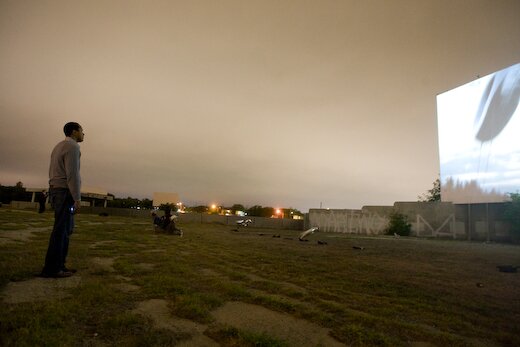
Eventually, as it grew dark, Arceneaux introduced the video, speaking of his search to learn something of his grandfather, a man neither he nor his father ever knew. This was a search to connect his identity to something larger, something more historically rooted. He spoke of his brief relationship with Linda Pace, who worked to create places in San Antonio that connect to what came before them: an old car dealership downtown becomes an artist residency space. This is the act of translating place — it doesn’t make sense to have car dealerships downtown anymore, but these spaces can be translated into something that is meaningful today, that turns loss and emptiness into another kind of value.
The video started, and as we watched Old Man Hill float away into the hills of Sarajevo, we also watched indecipherable words from another place float away into the San Antonio night, sometimes brushing slightly against the aging screen. And even as they disappeared from view, these words became embued with meaning. This was the final screening at the Mission Drive-In.
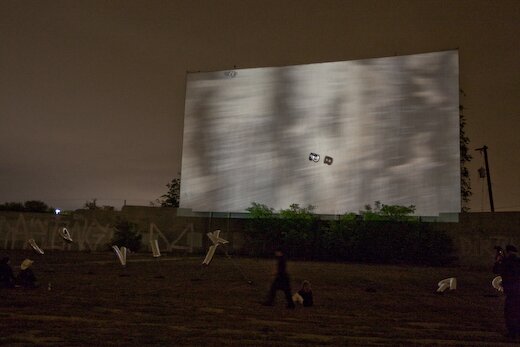
(Photos by Justin Parr, courtesy Linda Pace Foundation)
UPDATE: I’m honored to have Devin King respond to this in the second post on his new blog, Dancing Young Men From High Windows. Hopefully I’ll have time to respond to his post soon, but in the meantime I’ll point yall that way for an interesting reaction.
Posted by ben on 25 Mar 2009 | Tagged as: arts organizations, politics
The New York Times has a good overview of changes in arts policy and funding in the new Obama administration. This is the first I’d heard of the new White House arts adviser position, which seems similar to an idea Tyler Green proposed just after the inauguration. The arts adviser may have a bit less scope than Green envisioned, however. From the Times:
Mr. Ivey, who led the transition team devoted to the arts and recently met with Mr. Dale, said he expected the White House position to involve coordinating the work of the [National Endowment for the Arts], the National Endowment for the Humanities, and the Institute of Museum and Library Services.
Now here’s just one paragraph from Green’s intelligent discussion of the arts adviser he hoped for:
For example, in the wake of the No Child Left Behind law, arts education in America’s public schools has become a federal issue. There are internationally important arts treasures on government land, including Robert Smithson’s Spiral Jetty in Utah and Mount Rushmore, in South Dakota. Both face conservation issues. American museum directors increasingly run into thorny diplomatic issues while negotiating the potential return of antiquities to their countries of origin, but they have no place in the federal government with which to consult even though there are diplomatic implications to their decisions.
This would take someone with quite a bit more authority than just coordinating NEA, NEH, and IMLS. But we can hope that with time this adviser could become responsible for helping non-arts-specific agencies such as the Dept of Education, Pentagon and the National Park Service deal with tricky art-related issues that fall into their laps.
Much of the rest of the article deals with funding, pointing out that although Obama and the Democrats found $50 million for the NEA in the stimulus bill, and another $10 million in the omnibus spending bill, its funding is still lower than it was in 1992 (when it received $172 million).
There’s also the issue of not having appointed a chairman to the NEA, but this is a problem that is hardly specific to that agency; the Obama administration has been plagued with empty desks throughout numerous agencies, most troublingly the Treasury.
One thing not mentioned in the article is the immense quantity of bad art Obama is inspiring.
Posted by justin on 16 Mar 2009 | Tagged as: adventure day, art paparazzi, arts organizations, in yo face, party photos, performance art, possibilities, public art, rock!, silliness
Well, after a good deal of rain, some unexpected cold, and a little bit of worry, Luminaria 2009 turned out to be a really nice night in San Antonio. Aside from my experience with the overbearing police force (who wanted to tackle me for riding my bike down an empty LONG stretch of closed off road) I found this Luminaria to be much better organized and more satisfying to take part in. I carried my camera and photographed the projects I was able to come into personal contact with. Heres a selection of those photos, with my garbled commentary.
Laura Varela & Vaago Weiland collaborated on the Alamo this year. Vaago (from Mönchengladbach, Germany) said, in doing research on the Alamo, he kept coming across these photos with tents in the surrounding area. He was determined to surround the old Mission with 200 tents, however, upon closer inspection of the site was only able to squeeze in 54. Lauras video projection played alongside Vaagos sculpture, within the top of the Alamo.
Hyperbubble was the only real music I stood still and watched an entire set from. Not for lack of interesting options, but more in awe of the reaction of the crowd to their music. I heard more than several proclamations of “WHAT IS THIS?” and “THIS is the best band EVER!!” loudly from behind. I couldn’t have been happier.
My own piece (shamelessplug) was projected onto this old building(I was told it might have been called the Turner Magika Theatre?) facing out into the Hemisphere park, I showed the current version of my “Portrait of the Artist as a City,” a project I took up as a result of receiving a grant from the Artist Foundation. The video is made up of a constantly shifting set of over 9000 still photos, and encompasses more little parts of my life than I can begin to explain before losing your attention.
This year, the real showstopper for me was Ansen Seales 100 ft photograph of the San Antonio River. Contained inside the San Antonio Convention Center, It set the tone for the more conventional “walled,” section of the show. After talking to Ansen for a few minutes I was able to extract from him that this image was composed of 86,400 individual “slitscans,” made by his own homebuilt digital camera, and weighed in at a whopping 1.2 gigs for the file itself…and I thought trying to get my computer to juggle 9000 still photos at one time was tricky.
This fantastic ghost image of a dancer is local artist/instructor Rebecca Dietz. She was one of the roving performance artists, and a recent FL!GHT Gallery featured artist. I nearly missed her moving by me, and was glad I noticed who it was at the last minute.
John Mata, part of Leslie Raymonds New Media program at UTSA, built a cardboard room and filled it with books and media discussing…New Media.
Judith Cottrell & Gary Smith built this human like glowing form, and scared children for the duration of the night. I enjoyed watching.
Holly & Bryson Brooks decided it was best to be “Married with Paintings.” So they walked in at 6 on the dot, started working inside their makeshift studio(replete with audience the entire time), and by the time I rolled around with my camera, they were already at this point within each of their portraits of the other.
Back out on Alamo Street, Ethel Shipton had filled these two store front windows with her characteristic puffed objects, this time being birdhouses.
Kelly O’Connor was just a few windows down. My camera was having trouble not blowing out the detail in this one.
I stumbled upon this projection by Victor Pagona & his wife Sarah Susan, an artist I’ve heard of for years, but never met in San Antonio.
Sadly, I could only get this much of the smaller Leigh Anne Lester window displays without the detail of the sculptures being blown out by the harsh jewelry store lighting. These window displays will be available for all to see for the next month along Alamo Street.
I stumbled over this Michele Monseau projection right across the street from the Alamo, hidden on a side wall.
These patterns & lights can give you a general idea of what everything else looked like, that was not affected in some way by an individual artist or group of artists.
These two large scale Thomas Cummins Lightboxes, while difficult to do justice with a photograph, were mindblowingly detailed in person.
Another fine example of the general lighting scheme found that night. Its almost like that time I had to shoot photos at a certain laser light show..
Jenny Browne gave away 4 shopping cartloads and a truck bed full of books, for FREE, as her piece. It was awesome to see people swarming the truck and carts, trying to get at free books, while Jenny sat on the roof watching & laughing.
..and finally to end the weekend, Tom Otterness made an appearance with his newly unveiled(in our locale at least) public art piece, “Makin Hay’,” mentioned a few weeks back here at Emvergeoning. Some things I’m sorry to say I don’t have good photos of, the first being the EXCELLENT Contemporary Art Month installation by Randy Wallace in the basement of the old Beauty College building on Travis Street. I shot many photos of it, but none of them quite did it justice. I was also sad to miss crazy Mel Feldman and his cultural arts Kaleidoscope. Somehow 1000 artists all in one place on one night is just a LITTLE hard to keep track of.
Posted by ben on 11 Mar 2009 | Tagged as: adventure day, art paparazzi, arts organizations, graffiti, responses/reviews, sound art
Justin and I made it up to the third Texas Biennial last weekend, and managed to catch everything except Buster Graybill’s giant catfish, which was buried in some kind of enormous boating competition. The big picture take-away is that the Texas Biennial is committing itself to a more unified curatorial vision than in previous years, and to that end brought in writer / curator Michael Duncan from LA to curate the two group and four solo shows. The group shows were, however, not very unified, and I’ve found it difficult to tease overarching themes out of the scattered media, aesthetics, and ideas represented. One theme that did emerge for me is that much of the work expresses a kind of personal mythology, and hews away from overtly political statements. We also saw a lot of the more “traditional” media on display: well-crafted paintings, drawings, and sculptures were everywhere, and few installations or “post-media” sculpture-collages to be found. By my count, there were five videos, one sound sculpture, and one PowerPoint presentation out of hundreds of works. I haven’t quite figured out if this springs from the tastes of Michael Duncan or is supposed to be a reflection of the state of Texas art (although one catalog essay hints at the former: “This is not your average Whitney Program/Cal Arts/Artpace project” says the curator in reference to Lee Baxter Davis’ solo show) [UPDATE: This brief interview with Michael Duncan explains his approach to curating the Texas Biennial].
Here’s the run-down, with photos by Justin Parr:
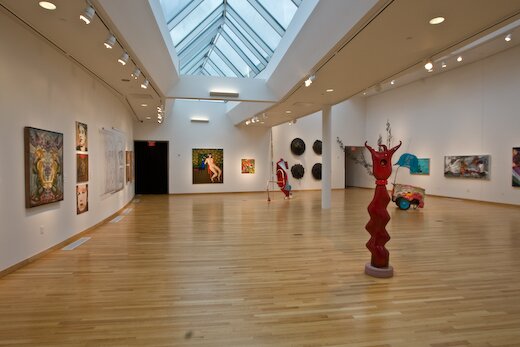
The group show at the Mexican American Cultural Center (run by Marfa Ballroom alum Simon Orta) was spacious and well-lit, with a lot of paintings, but also a nice sound sculpture by Justin Boyd outside the entrance:
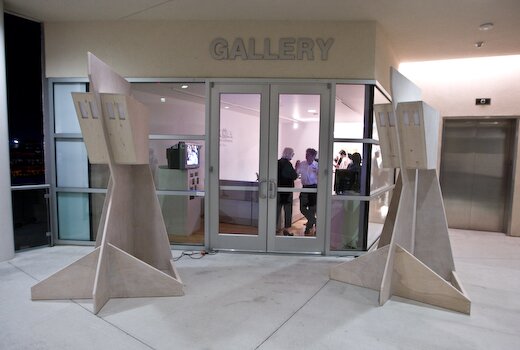
This sound sculpture plays recordings from the nearby river and powerlines to represent the flows of energy around the building — the physical sculpture references the architecture of the MACC itself. We didn’t get any photos from the opening of the group show at Women and Their Work because it was insanely crowded (and, searching on Flickr for “texas biennial 2009″, I get a bunch of photos… from the MACC, so maybe this wasn’t just a problem for us). Check out this slideshow at Women and Their Work’s website for some pics of the art.
The solo shows certainly felt more focused, and for the most part fit together better as a group than the group shows did. I’ll start with Jayne Lawrence, San Antonio artist and co-director of the Cactus Bra gallery, who represented the east (?) south* with a beautiful exhibit at MASS Gallery:

This is a huntress, although if you look closely you’ll see a large phallus between her legs — although Lawrence refers to all these creatures in the feminine, they are transgendered. This show consists of three human-size sculptures and a number of smaller drawings playing with ideas of mutation, a sort of biological collage across genders and species. Hunting and sexuality play big roles in these pieces as well, generating some really striking sex-and-death imagery. Here we have a creature who has been bitten in half by her lover, praying-mantis style:
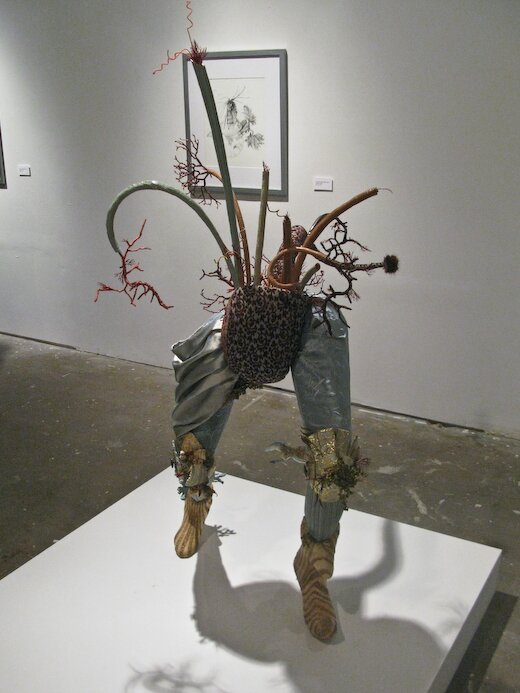
Lawrence combines textile, ceramic, plastic, papier mache, and other media in these highly textural and disorienting creatures. The drawings play with very similar organic themes, although some include architectural elements, hinting at a twisted Maker behind the scenes.
Lee Baxter Davis’ solo show at Pump Project consists of larger watercolors, embodying a mythology as dark as Lawrence’s, although of a somewhat less fantastical and more historicized nature:
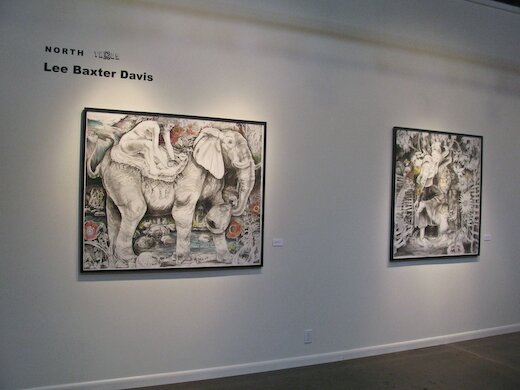
Strange narratives slip through the viewer’s fingers in this dense, magical-realist universe. It isn’t clear to me whether Davis is fictionalizing historical vignettes like Walton Ford, or spinning fresh tales out of a broad cultural experience. In any case, these works carry the tragic weight of a civilazation cutting into the wilderness, and fighting to stake out a stable place in the midst of chaos.
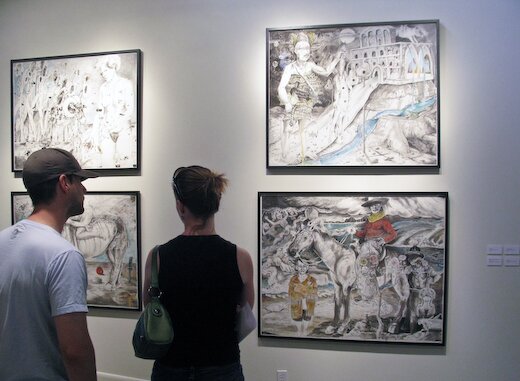
Moving on down to Big Medium, we encounter some large paintings that don’t have as much of the mythological or fantastical feel of Lawrence’s or Davis’ shows, but do play with the sexuality, violence and moral ambiguities contained there:

Representing the south east*, Vance’s beautifully rendered paintings from photographs depict psycho-sexual lesbian encounters, which, as Duncan points out in the catalog, are fraught with ambiguity. Themes of violence and humiliation are played against expressions of pleasure in ways that resist moral judgment. Vance is opening up private spaces that feel pure in their honesty, more direct than Lawrence’s fantasies or Davis’ narrative mazes. These scenes are radically intimate, without the weight of history or the complications of the world to get in the way of the pure relation.
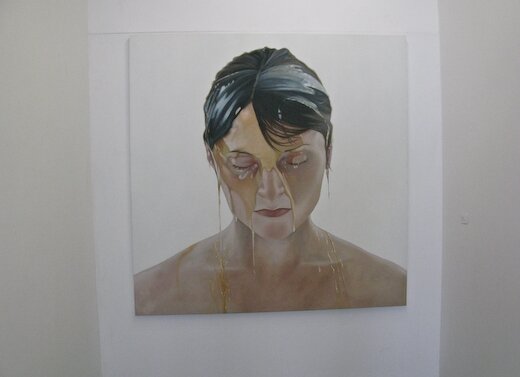
Finally we come to the West Texas show, Will Cannings at Okay Mountain. And here’s where the thematic development falls apart for me:
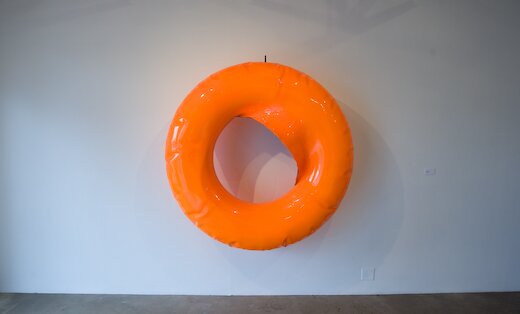
This is a steel sculpture inflated like plastic, or rather, over-inflated in this case, and burst along the inner seam. Personally, I couldn’t help thinking of Jeff Koons’ metal inflatable sculptures, although Michael Duncan was careful not mention those in the literature. It is largely a Pop affair, and it’s difficult to see how this show fits into the larger Biennial. The craftsmanship, though, is very tight, and Cannings put together a strong group that bridges the divide between Pop and Minimalism to some extent (one piece even directly references Brancusi):
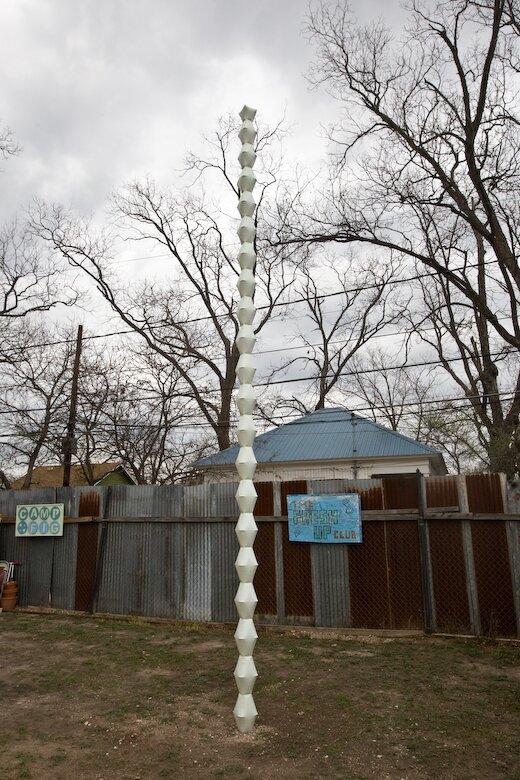
This post is getting pretty long, and I’ve got some other obligations this evening, so I’m going to save the outdoor pieces for another post. But in the meantime, I’ll leave you with some nice graffiti we stumbled on when we took a wrong turn on Shady Lane:

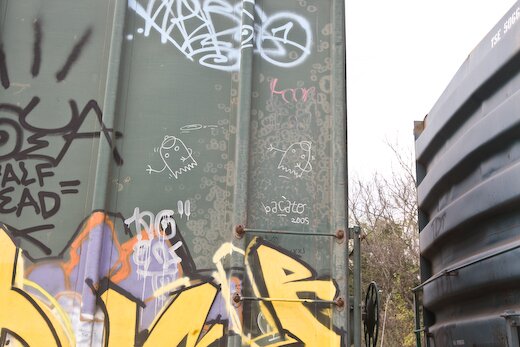
* Corrected thanks to commenter Salvador. That’s what I get for trusting the catalog…
Posted by ben on 03 Feb 2009 | Tagged as: arts organizations, links, opportunities
Had your eye on a hot gallery, but not quite sure how to approach it? Got your foot in the door, but you’re worried about making the right impression on your first studio visit? Just can’t find the right gallery for your work? Not even sure you should be in a gallery right now? Thought you loved your gallery, but it’s just not working out and you need to move on? Trying to figure out how to deal with that jealous gallerist who won’t even let you set foot in another gallery?
Get all the advice you need in Edward Winkleman’s handy round-up of artist-gallery relationship advice. FREE if you click now!
Posted by ben on 25 Jan 2009 | Tagged as: arts organizations, politics
Since Obama took office, I’ve seen a number of people call for the creation of a cabinet level Secretary of Arts (or Secretary of Culture), through op-eds, online petitions, and other channels. These proposals have left me cold for a few reasons. Most of the advocates of this measure frame it as a generic plea for the government to do more to support the arts. But why can’t congress just increase funding for the numerous federally controlled arts organizations that already exist? William Ferris also points out that the several existing arts-related government organizations (NEH, NEA, PBS, Library of Congress, Smithsonian, etc) sometimes have turf wars, and could benefit from some cabinet-level coordination and delineation of roles. Ok, but what is the nature of these conflicts, and could they be solved in another way?
I’ve not yet seen a really compelling argument for the Secretary of Arts position, which would, it must be admitted, seem rather frivolous to most Americans when the incoming administration has so many huge issues to deal with. A few days ago Tyler Green at Modern Art Notes proposed what seems like a much more practical move: appointing a White House arts adviser. Green takes as his model the White House science adviser, who deals with numerous agencies in coordinating a cohesive science policy. The White House arts adviser could play a similar role: advising the Department of Education on arts curriculum, the Pentagon on how to approach cultural monuments and institutions in occupied countries (remember the Iraq museum debacle?), the State Department on granting visas to visiting artists, etc. Apart from advising federal agencies, this arts advisor could help museums deal with the thorny issue of returning foreign artifacts to their home countries, and other non-federal matters that nonetheless have dimplomatic repercussions. Green discusses all these issues and more in laying out a pretty convincing case for this new appointment. Check it out.
Posted by aaron on 14 Jan 2009 | Tagged as: arts organizations, essays, in yo face, music, mustaches, possibilities, public art, r.i.p., rock!, wordy
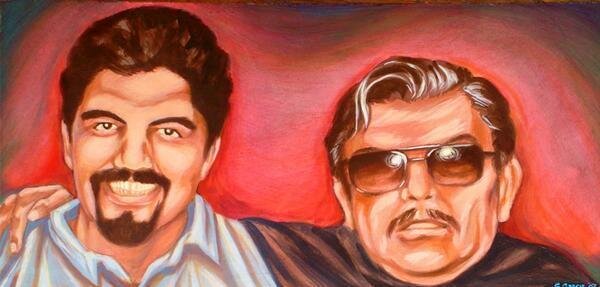
Manuel Diosdado Castillo, Jr. tragically succumbed to lung cancer on January 6th at the age of 40 – a matter of weeks after receiving the diagnosis – leaving behind a remarkable legacy of music, public artwork, of pride in and a powerful sense of responsibility for his beloved Westside San Antonio barrio. Manny was, for nearly twenty years, a singular presence in both the underground music scene in San Antonio (whose spiritual epicenter is marked by the centuries-old live oak tree at his favorite local dive/venue: the legendary, much-missed Tacoland) and in the non-profit community organization he built, originally as an offshoot project of Patti & Rod Radle’s Inner City Development, but which quickly blossomed into San Anto Cultural Arts.
My friendship with Manny goes back to a spontaneous garage rehearsal circa 1991. Marshall Gause and I were fruitlessly waiting at my folks’ house for some now forgotten drummer we wanted to try out, as our last band line-up hadn’t worked out. Marshall suggested trying to get in touch with this guy he had played a couple of times with the year before – they had enjoyed it, but it didn’t go anywhere as Manny soon left for New Orleans to follow Academic Pursuits. Marshall had a hunch he might be back in town now. After a few calls, the hunch was confirmed and we had a drummer on the way.
That first rehearsal (guitar, bass, & drums – singer Terry Brown had to work) immediately revealed an undeniable chemistry between Marshall’s hippy-punk musicologist guitar explorations, my intuitive but rudimentary bass playing (which, lucky for me, sounded better than it had much right to thanks to my chronic music obsession, a plethora of interesting audio exposure at a job selling used records, and especially Marshall’s unpretentious ability to cover for my lack of formal musical knowledge,) and Manny’s balls-out, hit-the-drums-hard-enough-to-break-at-least-one-head-per-session-but-always-dead-on-the-beat style, using complex rhythms even formally trained jazz drummers wouldn’t have the nerve to try. He was, and remains, one of the fastest, most precise drummers I have ever seen (even faster when he was nervous,) augmented by the physical strength to just bash the hell out of his drums – a steamroller cross between John Bonham, Neil Peart, Mitch Mitchell, George Hurley and Elvin Jones. All on a minimal and creaky drum set usually somehow held together with yarn.
That afternoon we quickly bonded musically over our mutual love for Rush, The Plugz, Esteban Jordan, Thin Lizzy and especially The Minutemen. Spontaneous jams we engaged in that day became the basis for numerous songs later fully developed and forming the initial base of our oeuvre (some still included in the set list at the time the band imploded.) In short order, we brought Terry back into the circle, sat around with some Lone Stars or whatever was cheap that day and soon agreed to call ourself El Santo, in homage to the legendary Mexican lucha enmascarada/film star who never lost a match.
Posted by ben on 13 Jan 2009 | Tagged as: arts organizations, comics, design, video/film
Paul Richards’ article in the Washington Post advocating for a Disney-based museum show has inspired some interesting responses around the blogosphere. Greg Allen makes a plausible case that it’s nothing more than “a fanboi/critic [trying] to turn some offhand party chatter about the worst show ever into a mouse-eared museum manifesto.” Kriston Capps, in a more even-keeled post gets a bit closer to what I see as the real problem with the idea:
To admit Disney would be to open up a massive new genealogy in visual art that includes all the things that are visual but aren’t called art. So it wouldn’t be Disney and Murakami or Disney and younger fine artists but Disney and the makers of Final Fantasy or Disney and the Coca Cola designers. That might all be defensible, but it would get very confusing very quickly.
Just because something is important does not make it visual art and at the end of the day, just because something is visual art does not mean that it is represents the most important visual thing. Rather this notion of visual art you find at museums offers a streamlined conversation within visual culture, one that (one hopes) influences and is influenced by other conversations in the broader culture. But museums cannot hope to archive all those other conversations, too.
But I think it’s not just a question of what is deemed visual art or what is deemed important. The issue comes down to a more practical question of access. Museums allow us to see genuine, rare works of art from a field that was founded on prizing the unique object. When you start to show Mickey Mouse cartoons, interesting and important as they may be to visual culture, you’re showing people things they can already see in the comfort of their homes. It’s not that the material is inappropriate for the museum, but that museum treatment isn’t necessary. Without the museum, many of us would never get to see a Frank Stella except as a reproduction; but if all the museums in the world disappeared, we could still participate in the visual culture of cinema, more or less in the way it was intended to be viewed.
Maybe we’re past the point where we refuse to consider Disney or Alfred Hitchcock or Matt Groening to be “real artists,” but that doesn’t mean that the public would be well-served by seeing their work in museums.
Posted by ben on 05 Jan 2009 | Tagged as: arts organizations, essays, possibilities, responses/reviews, wordy
Edward Winkleman posted a short essay on Saturday, which, in short, claims that the future of the art world is in fact the present of the art world. Citing Barack Obama, Winkleman ties the conventional wisdom about the impact of the internet on contemporary society to the current diaspora of the art world. While the underlying premise is not particularly new or insightful, it was a point that needed to be made: art world observers still looking for “the next big thing” need to take a deep breath and accept that fragmentation is here to stay; and this is, in fact, “the next big thing.” This isn’t a crisis, it’s just a way of being. Winkleman catalogs the effects our database-driven culture is having on the art scene, from curating to collecting to artmaking, and announces that these ripples will only expand as time marches on. What this means is that those looking for a new style or idea to dominate contemporary art culture will be disappointed. Poststructuralism is here to stay, and we’ve only begun to tap its implications.
Fair enough, but I think there’s another point to made here (which is perhaps just a shift in emphasis). Winkleman’s essay focusses on the anachronism, contrasts, and tension bred by a process that revels in referencing the Old Masters alongside contemporary pop culture, in drawing improbable threads through history. He emphasizes the information gathering, the cataloging, the futile but fascinating battle against being overwhelmed by the shear amount of information available to us.
But I think what’s most interesting about our current moment is the ways in which it potentially frees us from these obsessive chases, and actually opens up space for more genuine personal interactions. That might sound counter-intuitive at first, but the fact that there’s no longer a dominating formal or conceptual framework allows us to experience art on more personal terms. As a society, we may no longer reject certain styles of work as “unserious” — we may be forced to accept abstract expressionism alongside minimalism alongside realism alongside surrealism ad nauseum; but as individuals we are more free to just focus on the work that reaches us, rather than struggling to understand paint splatters because Greenberg told us to. And whatever style happens to appeal to you, whether it’s Mark Bradford, Walt Disney, Johathan Ive, Cecil Taylor, Bernard Leach or Outkast, there’ll be plenty of opportunities to make personal connections with others who care about the objects of your quirky taste. We can be more sincere about art if we allow ourselves to be.
So while Winkleman moves toward the conclusion that “art by concensus” will come into vogue, I’m more interested in how much more habitable the long tail is becoming: there are those of us interested in making the connections between styles and disciplines; and there are those whose myopic focus we leach off of to make our broad connections. For both groups, the world is becoming a , if more fragmented.
Posted by justin on 26 Nov 2008 | Tagged as: adventure day, architecture, art + bikes, art paparazzi, arts organizations
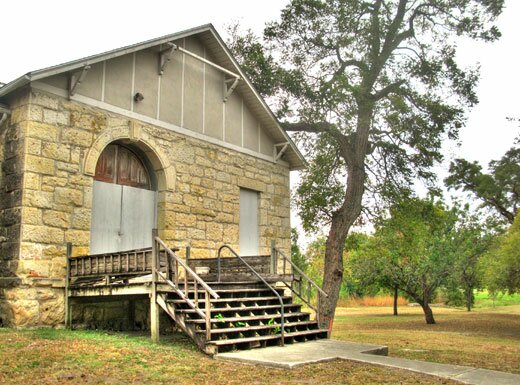
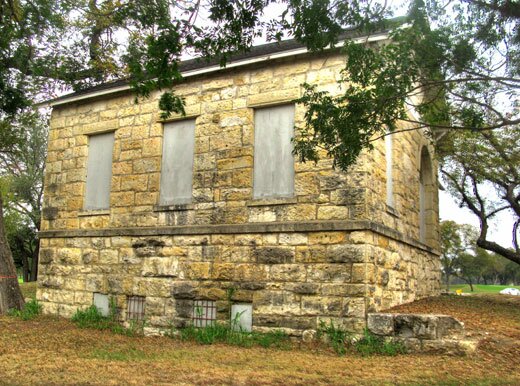
(Words by Gene Elder)
(Photos of Gutzon Borglum studio by Justin Parr)
(The following article is from CATCH-UP, a one issue art magazine that a group of San Antonio artists published in May of 1978.
I chose to write an article about Gutzon Borglum and his abandoned studio on the San Antonio River. It is an interesting history. Artists will find these facts important, as I did.
In 1978 we were protesting the lack of support for the arts. The abandoned studio of Gutzon Borglum where he created the model for Mt. Rushmore symbolized that lack of interest in the arts and the neglect of the creative community.)
IF ITS NOT THE ALAMO, then its just a studio
by Gene Elde_______________r
It has been my philosophy for some time now, that if you want to really enjoy an art exhibit, ignore the artist and the curator and go straight to the janitor. I have found that talking with the soul who picks up the trash after openings and daily sweeps the floors, empties ashtrays, polishes furniture and cleans the restrooms has the more interesting view of the arts. So with this in mind, I sat one Sunday on the steps of the Brackenridge Park Pumphouse and asked for wisdom from the Caretaker of the studio of Gutzon de la Mothe Borglum (The creator of Mount Rushmore.)
INNER VIEW:
There has not been a caretaker here in 10 years… people have forgotten this artistic heritage … but then perhaps that is the responsibility of a good studio, to remember the things that were created here and not to tell everything it knows.
But this studio told me that many times Gutzon sat here in ecstasy; thinking about the monument that would lift the hearts of America long after he had gone … (an artist learns that nothing is ever really his, only his to leave behind.)
Some of the time Gutzon sat here depressed and disenchanted from all the delays … but he understood that too. An artist is a servant as well as a leader and sometimes he must be both alone.
Many thought he was a little crazy … then again… most did not see the world the way Gutzon did.
This fateful studio, a two-story stone building near the Brackenridge golf course, was originally constructed under the supervision of George Washington Brackenridge in the mid-1880s. It served as the second pumphouse for the San Antonio Waterworks Co. until 1915 when it was abandoned. The pumphouse stood at the end of a long power canal which carried water to power turbines connected to a pump with a capacity of three million gallons daily. The water was lifted to the eastern end of Mahncke Park and in 1897 steam power was added to the station.
Gutzon moved to the abandoned pumphouse in 1924, using it as a studio for 13 years.
Now that the hor d’oeuvres have been served, to whet our appetite, shall we share a salad with our famous homemade house dressing?
While reading a book titled Unfinished Dream, by June Zeither and Lincoln Borglum, I enjoyed learning these things and have chronologically and alphabetically tossed them into the salad section.
Research revealed this famous South Dakota mountain site is named after a young New York attorney named Rushmore who was doing legal work for a mining company. When he asked the name of the peak, his companions answered lightly, “Hanged if we know! Lets call the damned thing Rushmore.”
Gutzon’s first model, completed in his winter studio in Brackenridge Park, was of three figures.
Washington: Since he represented the birth of the nation and the noble spirit which started a courageous people on an untried course.
Jefferson: To show the inspiration of the Declaration of Independence along with the foresight of the Louisiana purchase which expanded our country.
Lincoln: Representing the humanity, the suffering, the compassion, and the eternal unity of the nation.
When Roosevelt was chosen it brought forth a flood of controversy. Calvin Coolidge agreed with Gutzon that Roosevelt would properly round out this saga in stone. His enthusiasm for the American West, his efforts in behalf of labor along with the building of the Panama Canal, proclaimed Roosevelt to be the logical choice. To Gutzon this choice was right. “Regardless of what biased people may think of these four human beings, they were the ones who personified certain basic elements, crucial to our survival and growth as a nation.”
Not only was the choice of Roosevelt an issue, Gutzon’s angels commissioned by the Belmont Chapel of the Cathedral of St. John the Divine in New York City erupted into a nationwide controversy. The ecclesiastical hierarchy rejected the models on the grounds they appeared too feminine. “Angels,” they declared, “are masculine.”
Gutzon’s statue of Atlas bearing the weight of the world shocked the conservative. Delighting in this controversy, because “Atlas” turned out to be a woman, the sculptor explained that only woman has the strength and endurance for such a weight.
There was also a conflict with the Daughters of the Confederacy over Stone Mountain which ended with Gutzon destroying his clay models. They raised a furious cry and demanded the immediate arrest of the fleeing sculptor. Gutzon escaped into North Carolina with the law of Georgia hot on his heels. North Carolina’s Governor McLean announced he would call out the militia to protect the sculptor.
Besides being a sculptor, Gutzon served as a chairman of Central Park in New York and gave his thoughts to help San Antonio keep its historic Missions and meandering river. He also worked out an ambitious plan to beautify the entire state of Texas.
He gave a strong speech before the first National Arts Committee urging the government to promote a cultural consciousness in America. He felt that the government should scout out potential artist, but should never try to guide or mold the arts.
Gutzon’s plan for world peace was one of 20 selected for the Edward Bok American Peace Award for writers.
He regularly wrote “Letters to the Editor” delighting readers from coast to coast. They were well written, to the point, attention getting, and presented the unknown side of controversial issues.
Lincoln Borglum described his father as “a man of medium height, stocky build, and exceptionally broad shoulders. He had brown hair and piercing blue eyes. His cheeks were broad, his jaw square, and his chin determined. He was seldom seen without a brisk felt hat, which covered his balding head. His clothing was somewhat of a hybrid between that of an imaginative artist and a western bank president.”
Thrift, strict budgets, or bookkeeping were not necessary parts of Gutzon’s life. “Many times his commissions barely paid for the cost of his supplies, and often he would donate an important work, or turn part of his money back to the organization that commissioned him.”
Mount Rushmore took 16 years of his life. He died in debt, and his son, Lincoln, had to beg the government to pay Mary, Gutzon’s wife, the rest of the fees due Gutzon at his death.
Does
This
Ring
A
Bell
as we engage on an entree where it is
considered in bad taste to request
catsup ?
In 1937, Gutzon left his studio to the Witte Museum, where it was used for the Museum School of Art. This group eventually merged with the Art Institute, started by Marion Koogler McNay. Rumor revealed Etienne Ret, a French portrait painter invited here by Mrs. McNay to teach, worked in Gutzon’s studio. With these events a tradition was born. The tradition of handing down a studio. There were others who worked here before it closed in 1960; Max Fitzpatrick, Chester Tony, Jack Fletcher, and Dan Withers. Since then, various attempts have been made to utilize the building. Julie Black proposed a pottery studio in 1976, but the most recent renovation plan was prepared by Rudy Trevino. Today, after 18 years, we are slowly beginning to gather together at it’s cemented windows and locked door to re-call it’s role as contained in the words of Etienne Ret: “Perhaps I will not come back to teach, but I will come back, yes. San Antonio is after all one of the few cities where you can live life as it should be lived.”
Now there is a pleasant golf course with golfers walking and talking with the crew that maintains the lawns … joggers pass occasionally … people visit, even if only to ask questions about the pumphouse. But the community needs this place to be filled with artists again. It should be used as a meeting house by all the artists in San Antonio. Gutzon would like that.
Time has again brought us here to unlock The Studio doors. Not only the future, but now we know, the choice is to hear the knock or to ignore.
A Fortune Cookie,
begins our next course.
_____________________
CON SAFOS
_____________________
Posted by ben on 10 Nov 2008 | Tagged as: arts organizations, politics, silliness
George W. Bush: “Lame duck, huh? I’ll show you what a lame duck can do!”
Posted by justin on 04 Sep 2008 | Tagged as: announcements, arts organizations, upcoming events
From the website :
Calling all Texas artists! Visit www.artpace.org to submit your Open Call application for the 2010 International Artist-in-Residence program. Every year Texas artists are invited to submit material to be considered for a shortlist that will be reviewed by Artpace�s guest curators. Shortlisted artists� material will be examined by three curators, who may also conduct studio visits. From this process each curator identifies an innovative Texas artist to become an International Artist-in-Residence.
Posted by ben on 01 Aug 2008 | Tagged as: acquisitions, arts organizations, music, public art, sound art
Now that the first batch of artists commissioned for the Riverwalk expansion has been announced (there will be others as the expansion proceeds), I wanted to highlight the most historically significant artist selected, and the most interesting one to me personally: Bill Fontana. I missed the reception for him at Artpace earlier this week, so if you attended feel free to let us know how it went in comments.
Fontana studied at the New School for Social Research in New York, graduating with a B.A. in 1970. From 1972 to 1978 Fontana showed several sound sculptures in galleries, but it was in 1976 that he began producing the large-scale sound installations for which he has become known. Fontana’s work follows directly from the thought of John Cage, who was the most prominent inspiration for the early sound artists:
I began in the late 60s, when I was a student in New York and had taken a John Cage course at the New School, and was really beginning to experiment a lot with sound, found sound, recording sound and playback. The very first sound installation I made was in the very early seventies called Sound Sculpture With Resonators, in which I took some resonant objects, like large bottles that someone had made wine in, and placed them on the roof of a building in New York and put little acoustic microphones in them, and transmitted the sounds to the gallery space below. So you’d hear the object which became this very musical, filtered noise of the city. That’s probably one of the earliest works for me. [source]
In his work, Fontana chose to focus on the idea of musicality being a state of mind more than a characteristic of the sounds themselves:
I began my artistic career as a composer. What really began to interest me was not so much the music that I could write, but the states of mind I would experience when I felt musical enough to compose. In those moments, when I became musical, all the sounds around me also became musical. [source]
One thing that has distinguished Fontana from other sound artists (such as Max Neuhaus) is that throughout his career he has kept working with ambient sound, and never moved into electronically generated sound. He has often worked with types of sound displacement in installations such as “Sound Island” (1994) which allowed people at the Arc de Triomphe in Paris to hear ambient sounds from the coast of Normandy and from various locations in the city. This work, which is in a sense extremely minimal, has a number of historical and philosophical implications.
In “Harmonic Bridge,” on the other hand, Fontana deals not simply with displacement of sound, but with revealing the relationship between environmental sounds and the acoustic properties of objects within those environments. By applying microphones the London Millenium Foot Bridge, and amplifying sounds “hidden” in the bridge, Fontana reveals a “music” created from wind, foot traffic, etc., engaging with the resonant structure of the bridge itself. As with “Sound Island,” this piece has a number of social implications lurking just below the surface. A recording of “Harmonic Bridge” can be heard below.
Posted by ben on 30 Jul 2008 | Tagged as: acquisitions, announcements, arts organizations, marfa
MAN has the details on Robert Irwin’s forthcoming permanent installation at the Chinati Foundation in Marfa. Construction begins in 2010.